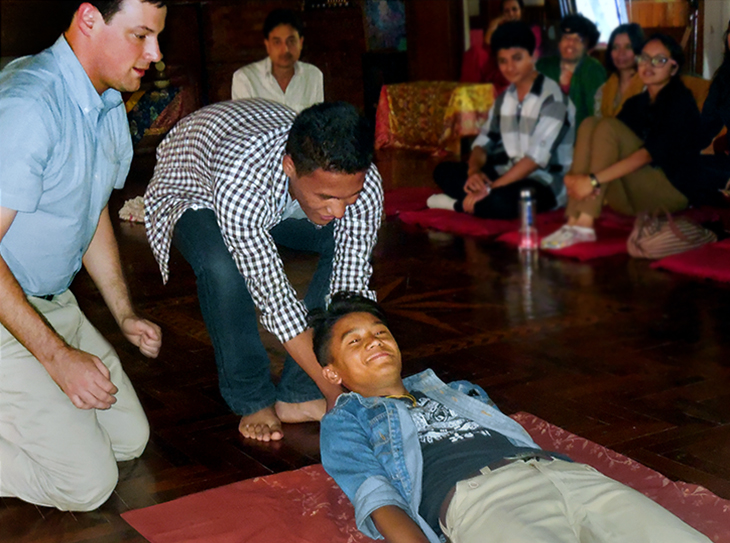Trauma program making a difference in Nepal

Through the Tulane Global Trauma Education Program, a Nepali mountaineer learns how to do a safe movement (“clothes drag”) with a colleague in Kathmandu, Nepal. The technique is used to extract a patient from a dangerous area while protecting the cervical spine. Jeremiah Kinsman, left, a practicing emergency medical technician for many years, received a master"s of public health from Tulane in May. (Photo by Dr. Bernard Jaffe)
Dr. Bernard Jaffe was on his way to Nepal, just one cross-Pacific flight away, when the Gorkha earthquake hit on April 25. The 7.9 magnitude quake killed more than 8,700 people and injured more than 22,000.
“I was sorry I wasn"t there,” Jaffe says. “I thought I could help.”
A professor emeritus in the Tulane University Department of Surgery, Jaffe is director of the Tulane Global Trauma Education Program, traveling with Tulane surgical residents and medical students to train people in Nepal, Bangladesh, Myanmar, Cambodia, Laos and Vietnam in emergency medical skills.
Tulane surgical resident Dr. Deitric Hennings had just checked into a hotel in Kathmandu, Nepal, awaiting Jaffe"s arrival, when the earthquake shook the area.
“He pulled a piece of glass out of someone"s chest, witnessed an amputation without anesthesia, and diagnosed tension pneumothorax ⦠a mortal injury that is easy to fix by inserting a needle into the chest,” Jaffe says.
From 2010 through 2014, Jaffe figures the program has trained 4,278 medical and nursing professionals; 941 police officers; 1,341 emergency medical technicians and 82 mountaineers in Southeast Asia.
Those individuals “also trained lots of individuals since, and we have no way of quantifying those,” Jaffe says.
“We train mostly lay people in a disaster, it"s the people in your neighborhood who can save your life. Your life relies on someone on your street knowing what to do when a building comes down.”
Even doctors may not know how to take care of people who have sustained traumatic injuries, Jaffe says. Trauma is the biggest killer of people under the age of 46, yet most medical students do not receive this life-saving training.
“These trips are unbelievably rewarding,” Jaffe says. “We will go back in the fall. This (Nepal"s damage) will be a 25-year problem to solve.”
“We train mostly lay people -- in a disaster, it's the people in your neighborhood who can save your life.”—Dr. Bernard Jaffe, professor emeritus of surgery
